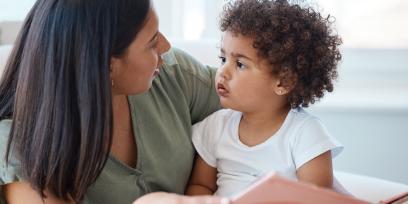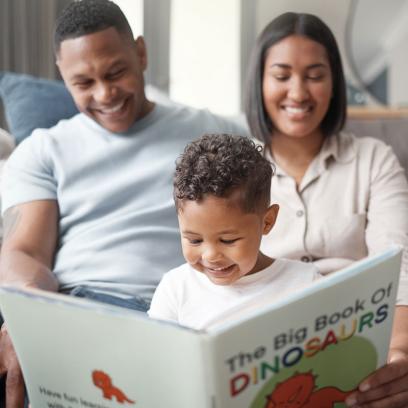elping your child learn to speak, read, and write in two or more languages is a wonderful gift that all families can give.* And it’s a gift that often leads to better cognitive skills and academic success on top of the benefits of bilingualism itself. Many common family activities—such as looking at magazines with your preschool-aged child, writing grocery lists, texting grandma, singing songs, and baking cookies—can promote early literacy. Regardless of the language used during these interactions, children are learning the essential skills that will unlock the mystery of print and open the world of reading and writing. In addition, because these activities are taking place in the home with the most important people in your child’s life, they set up life-long values and positive attitudes toward reading that will motivate future learning.
For families who speak a language other than English, the most important message I have to share is to recognize the power of your home language, your culturally based practices, and your close relationships to foster in your children a life-long love of reading. For example, if your family enjoys gathering to tell stories about your home country and ancestors, be sure to include your children (even 3- and 4-year-olds) so they can contribute to the conversation, ask questions, and share impressions. Through these traditions of storytelling and perhaps even singing songs together, your children are learning oral language skills (like listening to and understanding stories and speaking in complex sentences), which are necessary for future reading comprehension.
| Dual Language Learners: children, ages birth to five, who acquire two or more languages simultaneously and learn a second language while continuing to develop their first language. |
One key to developing children’s oral language skills is to help increase their vocabulary. The more words your child learns, the more stories and conversations they will understand—and the better they will be able to express themselves. Most 4-year-old children have a vocabulary of around 1,000-1,500 words. By the time they go to kindergarten, children typically know more than 2,000 words and can speak in complete sentences. Extensive research has shown that most dual language learners (DLLs) know fewer words in each of their languages than their monolingual peers, but when you combine both languages, their vocabulary size is comparable. For example, DLLs who speak a language other than English at home and have been learning English in a preschool setting may know some common words in their home language, like breakfast, bedroom, and window, and other words in English (the language of schooling), like pencil, playground, and journal. And, it’s common for DLLs to mix languages—beginning a sentence in one language, then switching to another.
For your child to apply their oral language skills to start reading, they need to learn about the alphabet: the names of letters, what sounds letters make, and how to put sounds together to make words. Children usually learn meaningful letters first—such as the letters in their name—and then other letters that they see often, such as the letters in the names of family members. There are lots of fun ways you can help your child build a bigger vocabulary and learn about the alphabet.
Family Activities
Ideally, families will support the development of both their home language and English. It is critical to continue to use your home language in everyday interactions (like those described below), especially if you are not fluent in English. If you understand and speak English at a high level, you may want to select certain times of the day or week when you use only English, such as during grocery shopping or some mealtimes. However, your primary job is to promote language and early literacy skills in your home language; this will build the foundation for early bilingualism and later school success in English.
Starting extended conversations: Throughout the day, there are opportunities to talk with your child. The more you listen to what your child is saying, respond to the content of your child’s speech, engage in repeated back-and-forth exchanges, and deliberately vary your vocabulary with longer sentences, the bigger your child’s vocabulary will be. Here’s an example:
Daughter, 4 years old, speaking to her mom: “Come look at my picture.”
Mom: “OK, Tell me about your picture. It looks like you decided to use many colors.”
Daughter: “I wanted to make the house beautiful and big.”
Mom: “That is an enormous house that is surrounded by gorgeous flowers that look very colorful. I wonder who planted these flowers.”
This conversation could go on for many more turns with continued use of more varied vocabulary words and complex sentences. By having frequent responsive language interactions with your child and deliberately inserting new and interesting words in longer sentences, you are building oral language skills that are critical to reading comprehension. You can also sing favorite nursery rhymes and make up new words to familiar melodies.
Reading books together: By 3 or 4 years of age, your child will probably have many favorite books that you have read repeatedly. When choosing books to enjoy together, it is important that you include books that are written in your home language and represent your cultural background. For instance, if you only speak and read Spanish, then reading picture books with interesting preschool-level stories in Spanish will help your child connect the printed word to the sounds of the spoken word. Your community library will most likely have books in Spanish as well as bilingual books that are appropriate for young children. They may also have weekday story times that you can attend with your child.
By encouraging your child to talk about the objects, people, pictures, and the plots of the books, you will also expand your child’s vocabulary and support their understanding of story sequence. Shared reading can also happen in other contexts: reading a recipe together while making dinner, labels on household items (including food packaging), and the signs around the neighborhood. The important message is that reading can stimulate imagination and bring joy to our lives—and it is essential to navigating the world.
Having fun with letters: You can help your child learn letters by:
- pointing out letters in names and common words (such as STOP and BUS in signs),
- singing the alphabet song, arranging magnetic letters on the refrigerator to spell family names, and
- encouraging your child to write short notes to other people.
For instance, 4-year-old Maria loves to write her name (almost legibly) at the top of every picture she draws. She has learned that the first letter in her name is M and sounds like “mmmm,” as well as other household items that start with the same sound/letter: mop, magazine, microwave. Each time Maria finds a new word that starts with M, her grandmother helps her find the magnetic letters and spell it. This helps her connect the sounds with the letters, and she can see how the new word looks. Her grandmother also gives her paper and different types of pencils, pens, markers, and crayons to help Maria practice writing (which also promotes early literacy).
If you engage in activities like these every day—sharing your love of your home language and of reading—your child will have a great foundation for becoming bilingual and biliterate.
Linda M. Espinosa is an emerita professor of early childhood education at the University of Missouri–Columbia who has led many studies and published widely on early childhood education and dual language learners.
* For more tips on helping your child become bilingual, see asha.org/public/speech/development/learning-two-languages. (return to article)
[photos: Getty Images]
 Member Benefits
Member Benefits Find Your Local
Find Your Local How to Join
How to Join En Espanol
En Espanol

